Academician Valentin Petrovich Glushko
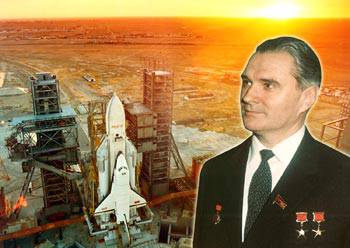 Modern Russian cosmonautics are indebted to this person for a lot of things, from the design of the engines of the Vostok spacecraft, on which the first space flight took place, to the creation of orbital space stations. Valentin Petrovich Glushko erected a monument in the center of his native Odessa on the avenue of the same name, despite the fact that for a long time he was among the classified people. For services to his fatherland, he was twice awarded the title Hero of Socialist Labor, five orders of Lenin, orders of the October Revolution and Red Banner of Labor, numerous medals, as well as a laureate of the State and Lenin Prize.
Modern Russian cosmonautics are indebted to this person for a lot of things, from the design of the engines of the Vostok spacecraft, on which the first space flight took place, to the creation of orbital space stations. Valentin Petrovich Glushko erected a monument in the center of his native Odessa on the avenue of the same name, despite the fact that for a long time he was among the classified people. For services to his fatherland, he was twice awarded the title Hero of Socialist Labor, five orders of Lenin, orders of the October Revolution and Red Banner of Labor, numerous medals, as well as a laureate of the State and Lenin Prize.Dreams of space
Valentin Glushko was born in 1908 in Odessa, after the revolution he entered a real school, then renamed Vocational School. Despite the difficult time for the country, the boy dreamed not of serving in the Red Army, as many of his peers. He was admired by the books of Jules Verne. After reading “From the Cannon to the Moon” and “Around the Moon” in 1921, little Valentine decided to devote the rest of his life to making such flights. He understood that this requires good knowledge, it is necessary to finish school, to enter a higher educational institution. He sincerely believed that the future was in space exploration.
At the same time, he became acquainted with the works of K. Tsiolkovsky. This is how Valentin Petrovich himself writes about this in his autobiography: “I found the first work of Tsiolkovsky in the Odessa public library. In the winter of 1922, it was not heated. Sitting in the reading room in my overcoat, I copied his blue fingers into my notebooks. In the 1923 year, 26 in September, I wrote a letter to K. E. Tsiolkovsky in Kaluga, Korovinskaya, 61, with a request to send his works. After a short time (October 8), to my great joy, I received a response letter from Tsiolkovsky along with some editions of his works. Soon Tsiolkovsky announced that from now on he would send me all the works published by him. Thus began the correspondence, which lasted a number of years. ” The correspondence, which Glushko carefully preserved, continued from 1923 to 1930. In his face, Tsiolkovsky found a devoted admirer who not only shared his dreams about space flights, but was ready to devote his life to this. In the 1924 year, when Valentine turned 16 years, he finished work on his first book, The Problem of Using Planets, with a page of 203. It was not taken at the publishing house, the work was too naive and emotional, as Glushko admitted after many years. But in this youthful work, the future academician outlined ideas, some of which he himself was later able to implement. In addition, he published a small popular science articles about space flight.
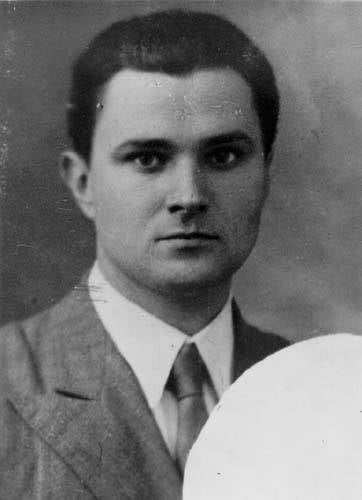
VPGlushko in the years of work at the Reactive Research Institute (RNII). Moscow. 1934 year
From theory to practice
After graduating from vocational school in 1924, Valentin Glushko entered the Leningrad State University in the physics department of the Faculty of Mathematics and Physics. As a thesis in 1929, he presented the project of the interplanetary spacecraft "Gelioraketoplan" with electric rocket engines. After graduation, he joined the staff of the Gas Dynamics Laboratory (GDL) as the head of the unit for the development of electric and liquid rockets and rocket engines, where he soon began working on the creation of the first Russian liquid propellant rocket engine (LRE) called ORM-1. During his work at GDL, Glushko designed the RLA-1, RLA-2, RLA-3 and RLA-100 missiles, developed designs and tested ORM engines using nitric acid-kerosene fuel.
In January 1934, Valentina Glushko was transferred to Moscow and was appointed head of the RNII Sector of the People's Commissariat of Defense. In December 1935 of the year he finished work on the book “Missiles, their device and use,” in parallel, he lectured at the N.E. Zhukovsky Air Force Engineering Academy. The following year he was appointed chief designer.
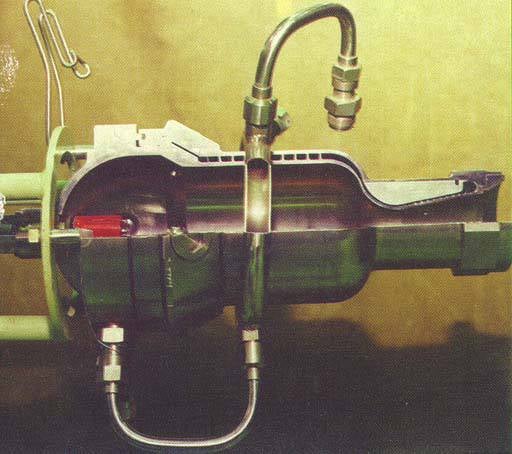
ORM-65 - a liquid-propellant rocket engine created by V.P. Glushko in 30-ies for installation on the RP-318 rocket plane and the 212 cruise missile designed by S.P. Korolev
Repressions and the Great Patriotic War
Valentin Glushko, like many scientists at that time, did not escape repression. He was arrested on 23 March 1938. Two days later, in the cellars of Lubyanka, he signed a confession: “I am a member of an anti-Soviet organization in the defense industry, on whose instructions I was conducting sabotage subversive work. In addition, I was engaged in espionage work in favor of Germany. " A few months later, in Butyrskaya Prison, he refused unsubstantiated accusations and began writing letters first to Vyshinsky, therefore to Yezhov and Stalin. The text was almost the same: “I request your order to review my case, instructing it on a new investigation, since the form of the interrogation I underwent was in the nature of moral and physical coercion, as a result of which I gave evidence that did not correspond to reality. I ask you not to slow down with the revision of my case (No. 18102), ensuring the normal method of investigation, since I have been in prison for 7 months. ” Of course, no one answered these letters.
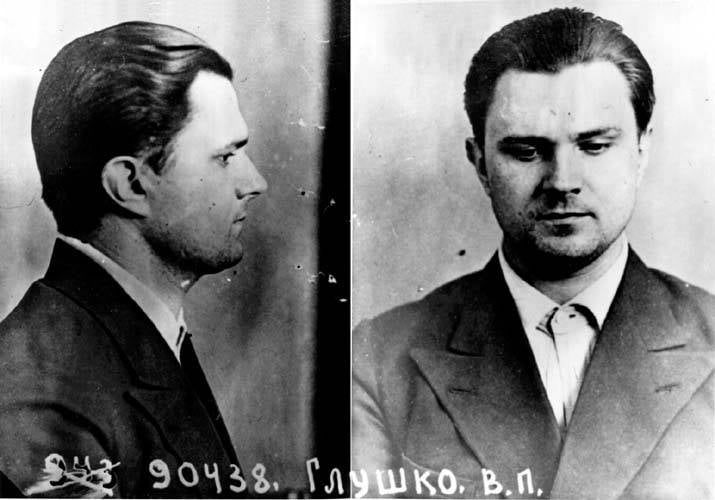
V.P.Glushko in the Butyrskaya prison in 1938. During the period of the Stalinist repressions, V.P.Glushko was arrested by the NKVD in a fabricated case and released only in 1944.
The next recipient is L. Beria. Glushko wrote: “Being slandered by the enemies of the people, I was arrested by 23.03.38 and subjected to moral and physical coercion by the investigative staff of the NKVD; as a result of the violence, I was forced to sign an interrogation protocol, the contents of which is nonsense, fiction.” He achieved only the replacement of the investigator, but it was impossible to win the case. 15 August 1939 The Special Meeting at the USSR People's Commissar of Internal Affairs issued a resolution: “Glushko Valentin Petrovich for taking part in a counterrevolutionary organization to end up in a forced labor camp for a term of eight years, counting the term from 23 in March 1938. Case file in the archive. "
However, by that time Glushko was already a very large specialist and was left to work in the technical bureau, and in 1940 he was transferred to Kazan, where the scientist continued to work as the chief designer of the NNVX Special Design Bureau of the NKVD at the Kazan Plant No. 4 for developing auxiliary aircraft engines. At the same time, Glushko had the exclusive right to recruit specialists for cooperation from those who were in the GULAG. He made a list of former employees and acquaintances, but most of them were already shot.
Zhiritsky, Strakhovich, Vitka, Liszt, Zheltukhin, Umansky and others worked with Glushko, and in 1942, at the request of Valentin Glushko, S. P. Korolev was transferred to Kazan. Together they developed military equipment. To begin with, the Pe-1 was equipped with a RD-2 engine, and its speed immediately increased by 180 km / h. After that, the engine improved and conducted a test cycle on the Yak-3, Su-7 and La-7 fighters. As a result, the increase in the speed of the aircraft was 200 km / h. So they put into operation a liquid jet engine that influenced the fate of rocket technology. Stalin appreciated the merits of Valentin Petrovich in the development of military aircraft, and 27 August 1944, he was released early with the removal of a criminal record. Glushko handed Stalin a list where more than 30 people indicated, asking for early release. Most of these people subsequently remained to work with Valentin Petrovich. From 1945, he headed the department of jet engines at the Kazan Aviation Institute.
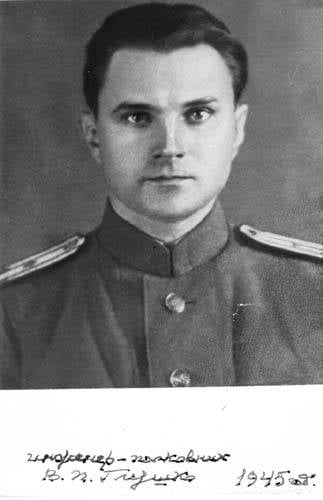 "Through the thorns to the stars"
"Through the thorns to the stars"After the war in 1945-1946, Glushko was on a business trip in Germany, where he studied German trophy rocket technology. He summarized the results of his observations in a memorandum to Minister of Arms Ustinov, in which he outlined the program for creating the rocket industry in the USSR and offered his candidacy for the post of chief designer of the rocket engine design bureau. In the summer of 1946, a team of design bureaus from Kazan was transferred to aircraft plant No. 456 in Khimki, which was reequipped to produce liquid rocket engines and later renamed NPO Energomash, and in 1970's, NPO Energia. In September 1948, the launch of the first rocket R-1 with a liquid-propellant rocket engine took place.
In 1953, Valentin Petrovich Glushko was elected a corresponding member of the USSR Academy of Sciences, and in 1957, the Higher Attestation Commission awarded him the degree of Doctor of Technical Sciences without defending a thesis. In 1960-1970, under the leadership of Chief Designer Glushko, programs were developed for the creation of manned orbital stations, lunar settlements, new reusable spacecraft, exploration of Mars and Venus, and flights to asteroids. It was the time of the great dream of space, when Valentine Petrovich fulfilled many of his childhood desires.
After the first artificial satellite in the USSR was launched into Earth orbit, rapid development of rocket production began. Under the leadership of Glushko was the development of a habitable lunar station. He wanted to draw public attention to this project, but all the work was done under the heading "top secret". After several unsuccessful launches of the H-1 rocket, the lunar program was completely closed.
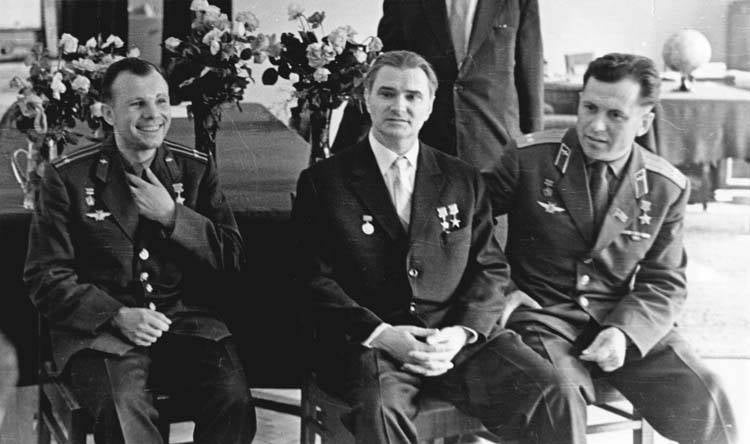
V.P.Glushko with cosmonauts Yu.A.Gagarin and P.Popovich in his office. 1963 year
In his first book, “Problems of exploitation of the planets,” the academician foresaw many inventions serving the exploration of outer space. So, he wrote: “The communication between the rocket and the Earth can be direct and should be made by means of a small apparatus, so this large rocket (we will call it an observation station), being always at the top, can have many different purposes.” And in the 1960-1970 years, Glushko participates in the development of the Salyut or Mir orbital complexes, and manned spacecraft Soyuz and transport Progress support the communication with the Earth.
In 1968, Valentin Glushko was appointed chairman of the Scientific Council on the “Liquid Fuel” problem at the Presidium of the USSR Academy of Sciences. In total, under his leadership, more than 50 liquid rocket engines and their modifications were created, which are used on 17 models of combat and space rockets. Also, its engines are installed on launch vehicles that launched automatic stations to the Moon, Venus and Mars, manned spacecraft Vostok, Voskhod and Soyuz, launched artificial satellites of the Earth and the Moon into orbits.
"Energy-Buran" - the last brainchild of Glushko
At the beginning of 1972, the United States began work on the Space Shuttle program, and in March in the Soviet Union at a meeting of the Military Industrial Commission discussed the creation of a domestic reusable space system. A month later, a meeting of designers led by Glushko was held, where they identified the problems of developing the ISS. The main difficulty was that disposable launch vehicles were more profitable both in terms of efficiency and cost, and there was no primary need to use reusable spacecraft. In addition, the task required an extraordinary approach and huge material costs, not to mention technical difficulties. Naturally, the Soviet ISS was not supposed to concede to the American "Shuttle" in anything.
They decided to start work only after the American shuttle made a maneuver over Moscow, descending from orbit to a height of just 80 km above the city, and then repeated it again. The order to create the Buran spacecraft was immediately adopted, and the development of this project began at NPO Energia, which was led by chief designer Glushko. The Buran was supposed to combine the properties of an ordinary airplane and an orbital spacecraft. Engineers are faced with the fact that in order to fulfill the set requirements it is necessary to create new heat-shielding materials, and right there appeared the problem of their testing.
Outside the ship is covered with ceramic tiles. Several tens of thousands of parts were calculated on the computer. All of them had a different shape and size, and manual calculation would require tens of thousands of drawings. The material could withstand large temperature differences. For the new carrier rocket, Glushko created the most powerful in the world, RD-170. As a result, the mechanical characteristics of the Buran not only did not yield to the Shuttle, but even surpassed it in some parameters.
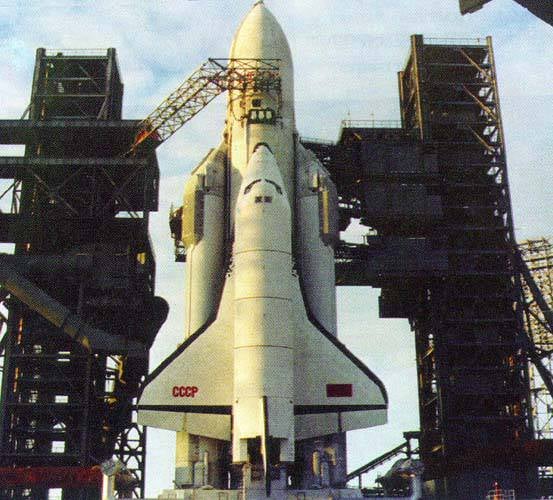
In total, the development of the ISS "Buran" gave 8 years, but the system was completely ready to be launched only by 1988 year. In 1987, a test launch of an Energia launch vehicle was conducted along with an experimental Polyus satellite. She did not go into orbit due to an error in flight in the satellite system, but made an excellent adjustment of the trajectory during landing.
The final launch of the ISS Energy-Buran from the Baikonur cosmodrome was scheduled for November 15 on 1988. The weather was unsuccessful, a storm warning was announced. But the launch still took place. The flight went according to plan. Separated from the carrier rocket, the Buran spacecraft reached the first cosmic velocity and went into a circular orbit, made two full orbits around the Earth. After 209 minutes after launch, the ship landed in automatic mode on the runway of Baikonur. Despite the difficult weather conditions, the landing was done flawlessly.
The launch of the ISS "Energy-Buran" meant the triumph of the national astronautics. However, the first flight of the ISS was the last. In 1989, at the age of 80, its creator Valentin Glushko died. The next launch of Buran was postponed first for two years, then another year, and more ... And the name of academician Glushko by the decision of the General Assembly of the International Astronomical Union in 1994 called the crater on the visible side of the moon.
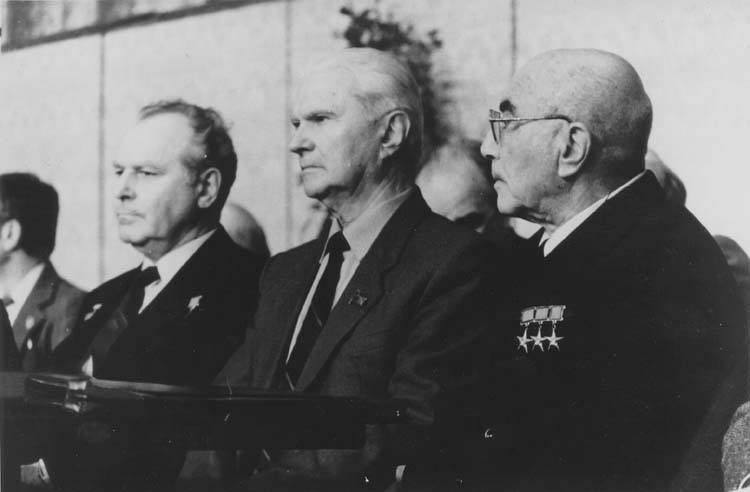
G.S. Titov, V.P.Glushko, Ya.B.Zeldovich in the Presidium of the International Congress on Mars "Cooperation in Space for Peace on Earth". 1987 year
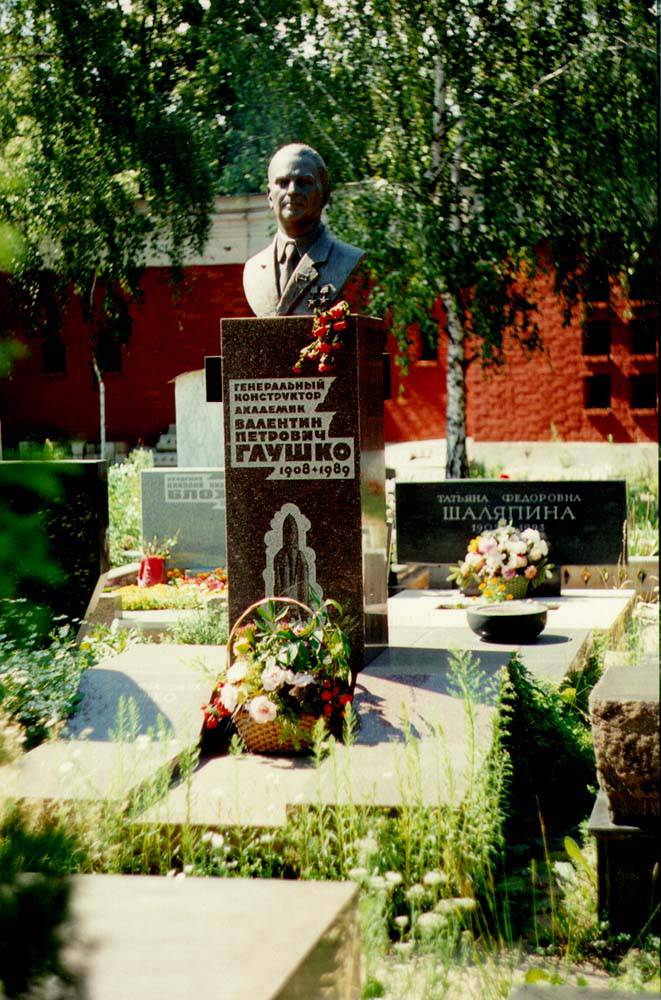
Monument to VPGlushko at his grave at the Novodevichy Cemetery in Moscow
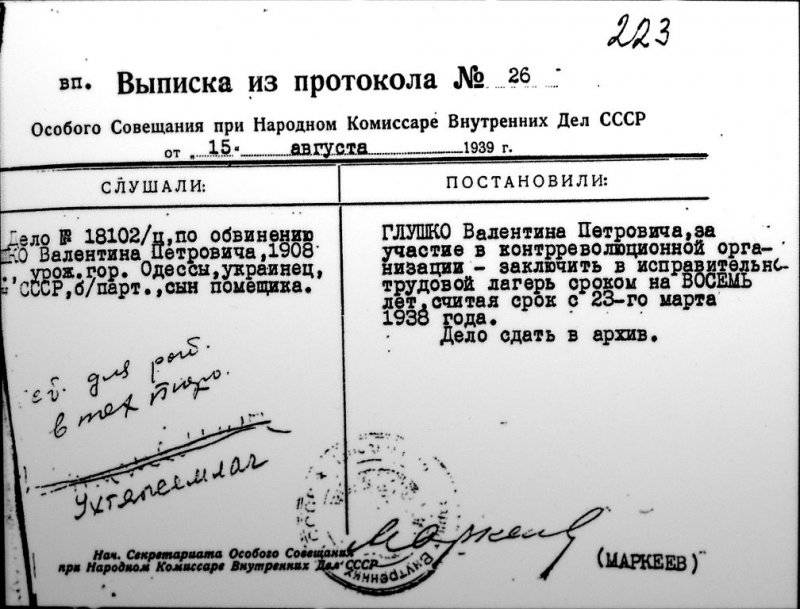
Information